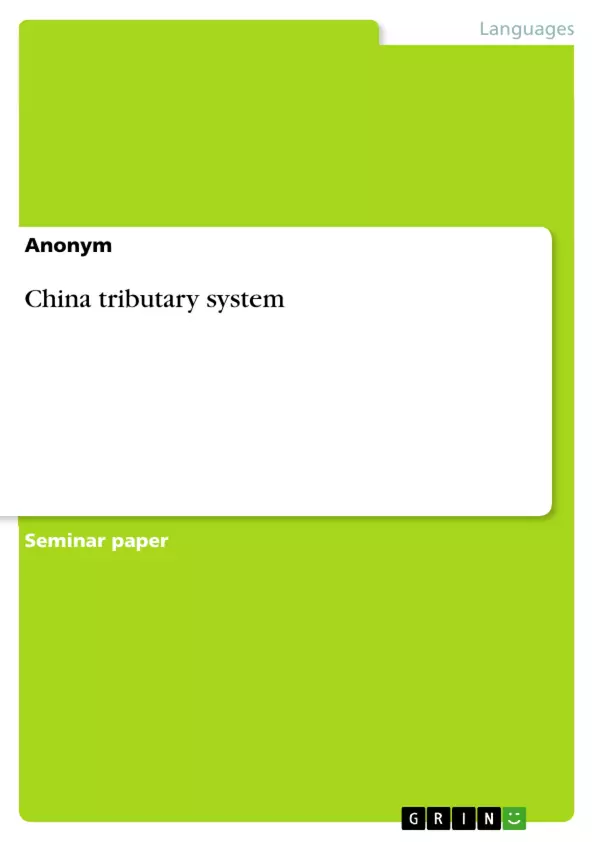The focus of my term paper is that Chinas tributary order is not just a political arrangement but more than that, where political arrangement focuses on how power is organised, the tributary order looks at the bigger picture. It includes how countries interact economically, how their cultures influence and are influenced by each other, and how they work together to keep things peaceful. It's like a multi-dimensional system that goes beyond just rules and power to shape various aspects of the relationships between China and the tributary states. actually reprinted.
In the vast lands of East Asia, a powerful empire known a the China stood a the central figure in a complex web of relationships. This empires tributary order, often misunderstood as a mere political arrangement. Here political arrangements refers to the structure and organisation of power within the system, the tributary order goes beyond that to encompass other dimensions such as economic, cultural, and social aspects. In the tributary order, the political arrangement is like the rules and power structure. It's about how China is in charge and how the tributary states submit to its authority. However, the tributary order is more than just that. It also involves things like trading goods and benefiting economically from the relationship, sharing and adopting aspects of Chinese culture, and working together to maintain stability and order in the region.
Table of Contents
- INTRODUCTION
- "TRIBUTARY ORDER MORE THAN JUST A POLITICAL ARRANGEMENT"
- Submission and Recognition
- Economic Aspects
- Cultural Elements
- Regional Order and Stability
- CONCLUSION
Objectives and Key Themes
This term paper explores the intricate nature of China’s tributary order, moving beyond its conventional understanding as merely a political arrangement. It delves into the multifaceted aspects of this historical system, encompassing economic, cultural, and social dimensions that shaped relationships between China and its tributary states.
- The multifaceted nature of China's tributary order beyond a political arrangement
- The role of submission and recognition in solidifying China's hegemonic control
- Economic advantages and interdependence generated by the tributary system
- Cultural diffusion and China's influence on tributary states
- The establishment of regional order and stability through the tributary system
Chapter Summaries
- INTRODUCTION: This chapter introduces the concept of China’s tributary order as a complex system extending beyond political arrangements. It highlights the economic, cultural, and social aspects that contributed to its significance in East Asian history. The chapter cites John Fairbank’s recognition of the tributary system's importance in shaping China’s relations with neighboring countries.
- "TRIBUTARY ORDER MORE THAN JUST A POLITICAL ARRANGEMENT": This section delves into the symbolic nature of the tributary order, emphasizing the role of the Chinese emperor as the "Son of Heaven." It explores how the practice of submission reinforced China's power and influence over tributary states, exemplified by the Korean Joseon dynasty's emulation of Chinese court rituals.
- Submission and Recognition: This chapter examines the central elements of submission and recognition within the tributary system. It highlights how tributary states would send missions to pay homage, acknowledging China's superior position. Confucian ideals of hierarchy, reciprocity, and moral conduct shaped these interactions, solidifying China's dominance and establishing a framework for diplomatic relations. The chapter also explores the motivations behind states' submission, including political considerations, economic factors, and cultural prestige.
- Economic Aspects: This section focuses on the economic implications of the tributary system. It details how tributary states gained access to Chinese markets while contributing through tribute payments. The chapter analyzes how this system fostered economic dependency on China, highlighting examples like the Tuntian system imposed on the Ryukyu kingdom and China's trade relations with Vietnam. It emphasizes how China used its economic control to strengthen its position and accumulate wealth within the regional order.
- Cultural Elements: This chapter delves into the cultural aspects of the tributary order, emphasizing the role of Confucianism. It explores how the diffusion of Chinese culture through rituals, literature, and philosophy cemented China's cultural influence on tributary states. The chapter uses examples like the adoption of Chinese administrative practices and Confucian ideology by Vietnam and Korea to illustrate how China's cultural supremacy permeated these societies.
- Regional Order and Stability: This section examines the tributary system's contribution to establishing regional order and stability in East Asia. It argues that by incorporating neighboring states, China acted as a unifying force, minimizing internal conflicts and reducing external threats. The chapter highlights how the hierarchical structure of the system provided a framework for managing relations among vassal states, with China acting as a mediator and guarantor of peace. It uses the example of China's role in resolving border disputes between Vietnam and Champa to illustrate its contribution to regional stability.
Keywords
The key concepts explored in this term paper include China's tributary order, hegemonic control, submission and recognition, economic interdependence, cultural diffusion, Confucianism, Sinocentrism, regional order, and stability in East Asia. These keywords encapsulate the primary themes and focus topics of the work, revealing the multifaceted nature of China's historical system and its impact on regional relationships.
- Quote paper
- Anonym (Author), 2023, China tributary system , Munich, GRIN Verlag, https://www.hausarbeiten.de/document/1471932


